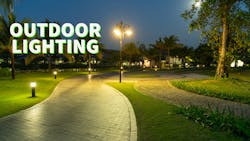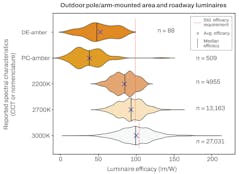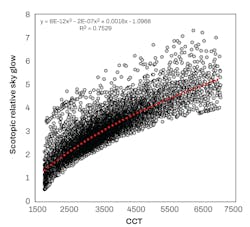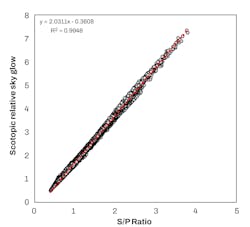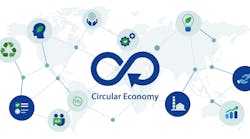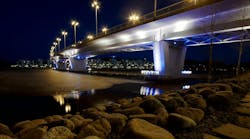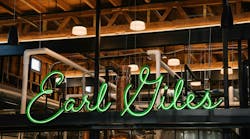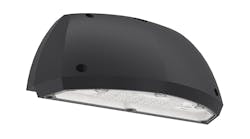As temperatures cool and daylight wanes, an age-old occurrence is unfolding. In North America alone, billions of birds are migrating to their wintering grounds from mid-August through November1, covering distances of hundreds, if not thousands, of miles — typically at night.
Unfortunately, this mass movement of biodiversity is another piece of the natural world feeling the negative effects of human activity — specifically, light pollution. Excessive and poorly controlled nighttime lighting likely interferes with the autumn migration of 80% of North American birds, some of which become disoriented, collide with buildings, or circle and recircle illuminated structures and beams of light2 to the point of exhaustion. Between 356 million and 988 million birds are estimated to die3 in building collisions during the day and night in the U.S. annually.
Now is an apt time of year to talk about what the lighting industry can do — and is doing — to mitigate this harm while simultaneously saving energy, providing better nighttime lighting for human communities, and lessening negative impacts on the natural environment.
The DesignLights Consortium (DLC) introduced its LUNA V1 Technical Requirements in 2021 to address these problems. Released after more than a year of research and development, LUNA is an additional set of requirements for a subset of products covered by the DLC’s Solid-State Lighting (SSL) Technical Requirements. As such, the policy promotes adoption of LED luminaires that meet the DLC’s specifications for energy efficiency while providing appropriate nighttime visibility for people, limiting sky glow and light trespass, and helping to mitigate light pollution.
Artificial light at night (ALAN) that is excessive, poorly controlled, and/or illuminating places unnecessarily is associated with a host of problems. Sky glow — the cumulative scattering of direct and reflected light across the night sky, for example — now obscures the Milky Way4 from the view of over a third of the world’s inhabitants, including 80% of North Americans. Sky glow is not limited to urban centers and municipalities. It is visible as far as 200 miles away and can cause deleterious impacts on a range of nonhuman organisms.
Beyond bird migration, light trespass has also been shown to interfere with insect behavior5, seasonal and photoperiodic plant responses6, nocturnal pollination7, and turtle hatchlings’8 ability to successfully navigate routes to the ocean from coastal nesting sites.
Inappropriate nighttime lighting hampers human communities as well. Driven by racial stereotypes and fear, past and present public policy decisions have often led to overlighting in underrepresented communities9, historically undermining the wellbeing of residents.
These impacts to ecosystems and humans are taking place against the backdrop of a clear economic argument for reining in light pollution. One-third of all nighttime lighting in the U.S. is wasted due largely to unshielded luminaires, costing facility owners more than $3 billion annually, according to the International Dark-Sky Association. This wasted electricity contributes to the climate crisis as well, to the tune of 21 million tons of carbon emissions each year.
The DLC began implementing its LUNA policy this year, and the first products listed under the LUNA qualification were added to the SSL Qualified Products List (QPL) on July 27, 2022. The policy and LUNA listings are designed to streamline the process of selecting efficient outdoor lighting products that minimize sky glow and light trespass while yielding the efficiency and maintenance benefits of LED lighting. With the LUNA requirements in place, municipalities, utilities, and efficiency programs can better support their energy reduction goals and abide by dark-sky policies and ordinances. LUNA also helps specifiers to fulfill the light pollution and trespass requirements of LEED and WELL building programs, and helps projects follow application guidance in the joint IDA-IES Model Lighting Ordinance.
Like the DLC’s other technical requirements, the LUNA policy will inform design of energy-efficiency incentives administered by utilities and other programs.
Importantly, LUNA V1 currently does not include nonwhite light (NWL) sources, such as amber, that eliminate the short-wavelength radiation linked to disruption of natural ecosystems. While outdoor amber LED luminaires have emerged as a potential strategy to limit light pollution and other negative effects of ALAN, insufficient standards and the need for new performance thresholds for these products prevent their inclusion in the LUNA V1 technical requirements.
Figure 1 shows the efficacy values for commercially available LED luminaires with amber LEDs and phosphor-converted (PC-) white LEDs with CCTs of 3000K and lower. The evaluated amber LED luminaires would not meet the LUNA efficacy thresholds. As a result, only white-light LED outdoor products with CCTs between 2200K and 3000K are allowed in LUNA V1.
In response to questions about including NWL in LUNA, the DLC examined the issue in a white paper published earlier this year (available for download from the DLC website). Authors of that report found several significant gaps in research, standards, and guidelines regarding NWL/amber LED products that must be addressed before the DLC can consider adding these products to the LUNA program.
In terms of best practices for limiting sky glow — one of the main objectives of LUNA — lighting scientists generally point to a set of basic guidelines:
- Limit overlighting.
- Limit uplight emitted by a luminaire.
- Impose a curfew, after which lights must be dimmed or switched off.
- Minimize short-wavelength light by implementing a maximum CCT or limiting short-wavelength radiation in another way.
The Illuminating Engineering Society’s TM-37-21 publication, a technical memorandum on sky glow referenced in LUNA, echoes the four strategies listed. Generally, limiting overlighting via specification, design, and implementing controls is the best way to limit sky glow, followed next by limiting uplight, and then by minimizing short-wavelength content.
Methods for limiting light trespass, another LUNA priority, typically focus on shielding fixtures in conjunction with the selection of appropriate optics for each application.
As a qualification option under the DLC’s SSL Version 5.1 Technical Requirements, LUNA adds value throughout the outdoor fixture specification, selection, and utilization process. Since LUNA is a holistic set of requirements, luminaires listed under the LUNA qualification not only meet light distribution and CCT thresholds but also adhere to the underlying SSL V5.1 requirements for lumen and color maintenance, minimum color rendition, warranty and safety certifications, and efficacy. The latter is especially important for energy-efficiency incentive eligibility, as V5.1 SSL products have increased in efficacy by an average of 70% since 2011.
Other programmatic elements associated with the LUNA technical requirements include:
- LUNA listed fixtures must continuously dim to at least 20%, enabling adaptive dimming.
- Manufacturers must report which integral controls are available on each fixture.
- SSL QPL users can see an image of each LUNA listed fixture’s spatial distribution for each unique optic.
- SSL QPL users can see an image of the spectral power distribution (SPD) and download SPD data corresponding with the listed LUNA fixture’s maximum and minimum CCTs.
The DLC is implementing LUNA V1 with the expectation that lighting metrics will evolve as scientific insights emerge and best practices for outdoor lighting are continuously refined. For example, while LUNA currently relies on maximum CCT to limit short-wavelength content, the DLC believes the lighting industry needs a better spectral metric than CCT to predict the spectral impacts of light on sky glow and other relevant outcome measures. The DLC’s recent white paper found that CCT was a poor predictor of relative sky glow due to spectrum (Fig. 2), while the scotopic/photopic (S/P) ratio was the strongest predictor of relative sky glow due to spectrum (Fig. 3). Low S/P ratios are associated with low relative sky glow, all else (e.g., light output and distribution) being equal. As is the case with all its technical requirements, the DLC will seek stakeholder input and continue to update and refine the LUNA policy over time.
By bringing a robust performance specification to the outdoor lighting market that includes V5.1 elements and technical requirements meant to protect dark skies, the DLC’s LUNA program works to balance the reality that outdoor LED lighting contributes to light pollution with the value that outdoor LED lighting provides. We are confident that a combination of good design and the right products can guide the industry on a positive path — one that promotes the efficiency advances of LED lighting while minimizing sky glow and light trespass and ultimately reducing light pollution for the benefit of stargazers, neighborhoods, and natural ecosystems alike.
REFERENCES
1. BirdCast, Live bird migration maps.
2. B.M. Van Doren et al., “High-intensity urban light installation dramatically alters nocturnal bird migration,” PNAS, 114:42, 11175–1118 (Oct. 2, 2017).
3. S.R. Loss et al., “Direct mortality of birds from anthropogenic causes,” Annu Rev Ecol Evol Syst, 46, 99–120 (Sept. 15, 2015).
4. F. Falchi et al., “The new world atlas of artificial night sky brightness,” ScienceAdvances, 2:6 (June 10, 2016).
5. A.J.A. Stewart, “Impacts of artificial lighting at night on insect conservation,” Insect Conservation and Diversity, 14:2, 163–166 (March 16, 2021).
6. R.K. Singhal et al., “Eco-physiological responses of artificial night light pollution in plants,” Russian J Plant Phys, 66, 190–202 (July 1, 2019).
7. E. Knop et al., “Artificial light at night as a new threat to pollination,” Nature, 548, 206–209 (Aug. 2, 2017).
8. M. Salmon, “Artificial night lighting and sea turtles,” Biologist, 50:4, 163-168 (2003).
9. M. Sloane et al., “Tackling social inequalities in public lighting,” Report by The Configuring Light/Staging the Social Research program, The London School of Economics and Political Science (May 2016).
Get to know our expert
With more than 20 years of experience in the lighting industry, senior lighting scientist LEORA RADETSKY provides lighting science input for the DesignLights Consortium’s technical requirements. Radetsky came to the DLC with experience as a research scientist at Rensselaer Polytechnic Institute’s (RPI) Lighting Research Center and director of customer education at a prominent lighting software company. A recipient of an Illuminating Engineering Society (IES) Regional Technical Award from the Northeast region, she is also Lighting Certified by the National Council on Qualifications for the Lighting Professions, and a member of IES and the American Society of Agricultural and Biological Engineers. In addition to a master’s degree in Lighting from RPI, Radetsky holds a bachelor of science in Architectural Engineering with an Emphasis in Illumination from the University of Colorado.
For up-to-the-minute LED and SSL updates, follow us on Twitter. You’ll find curated content and commentary, as well as information on industry events, webcasts, and surveys on our LinkedIn page and our Facebook page.
